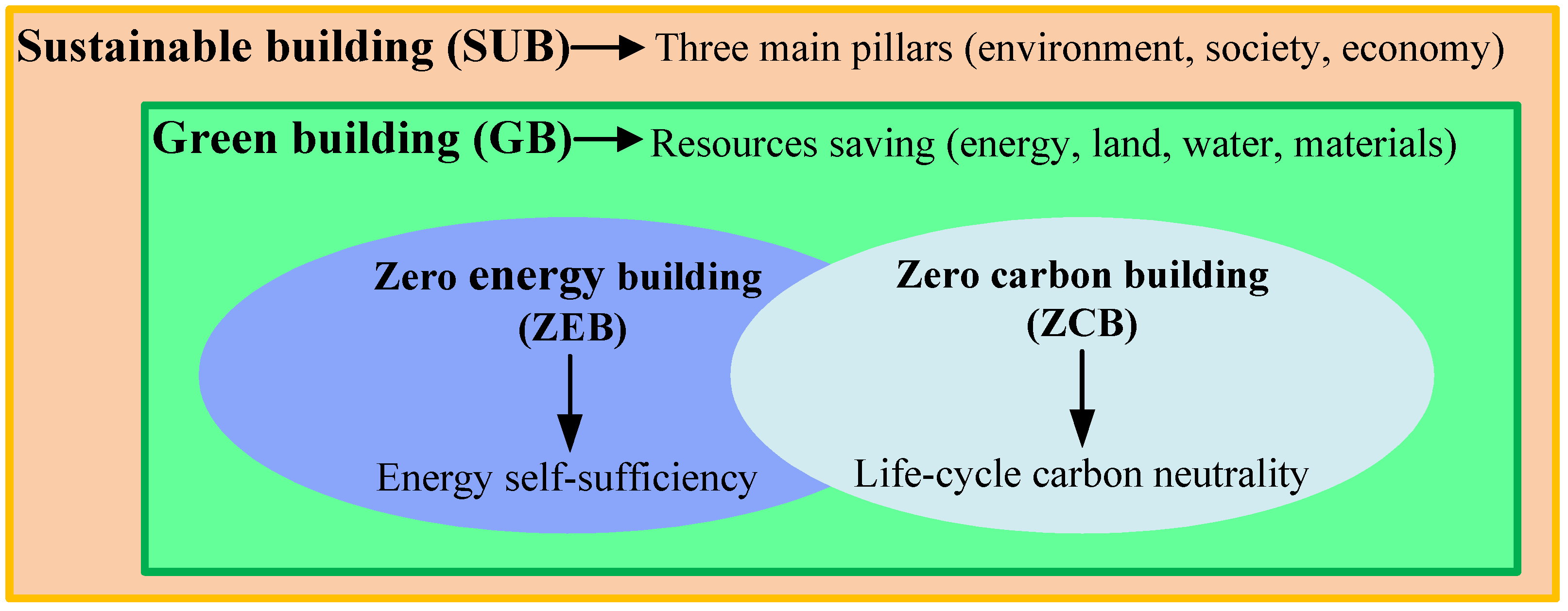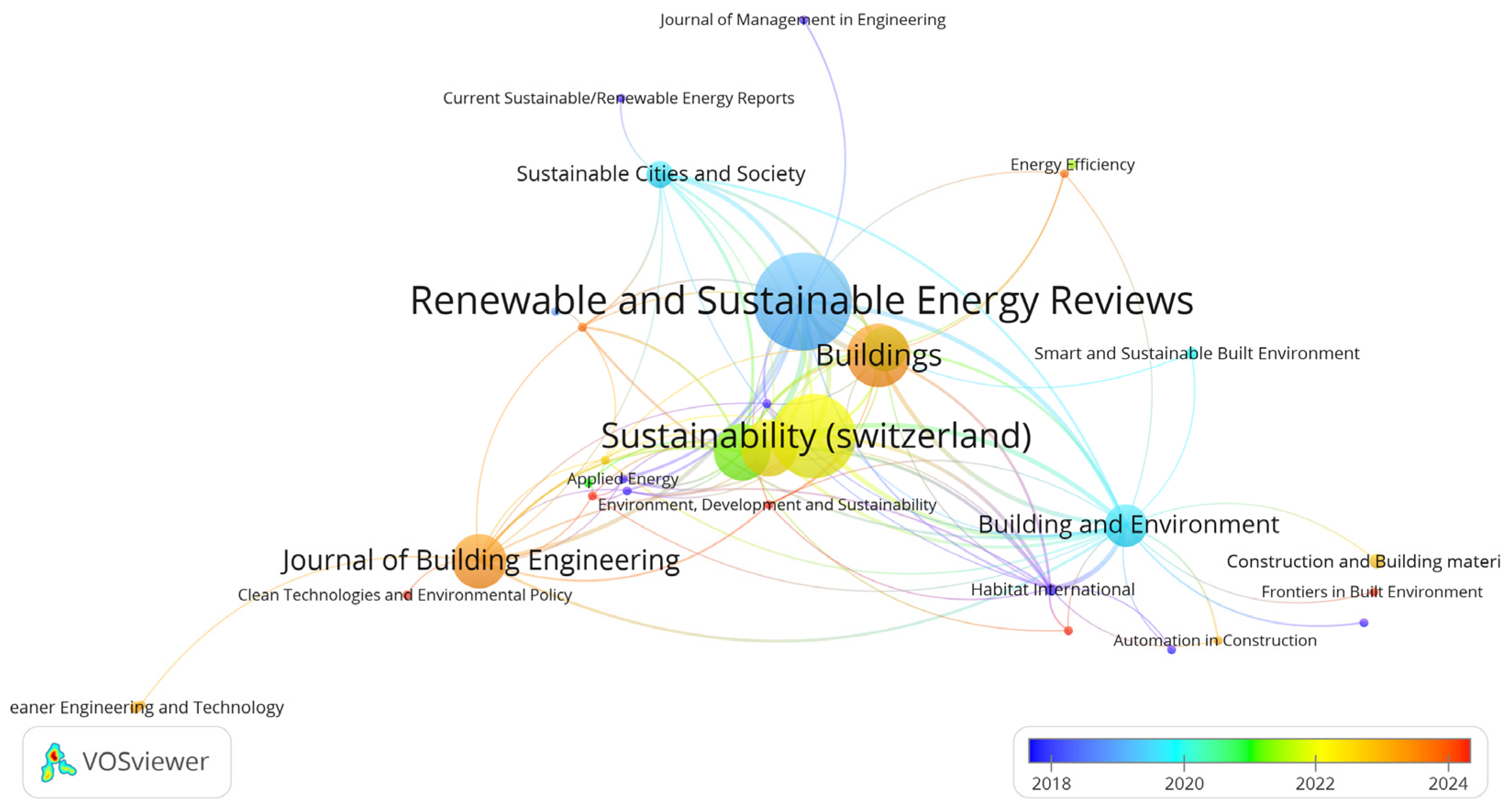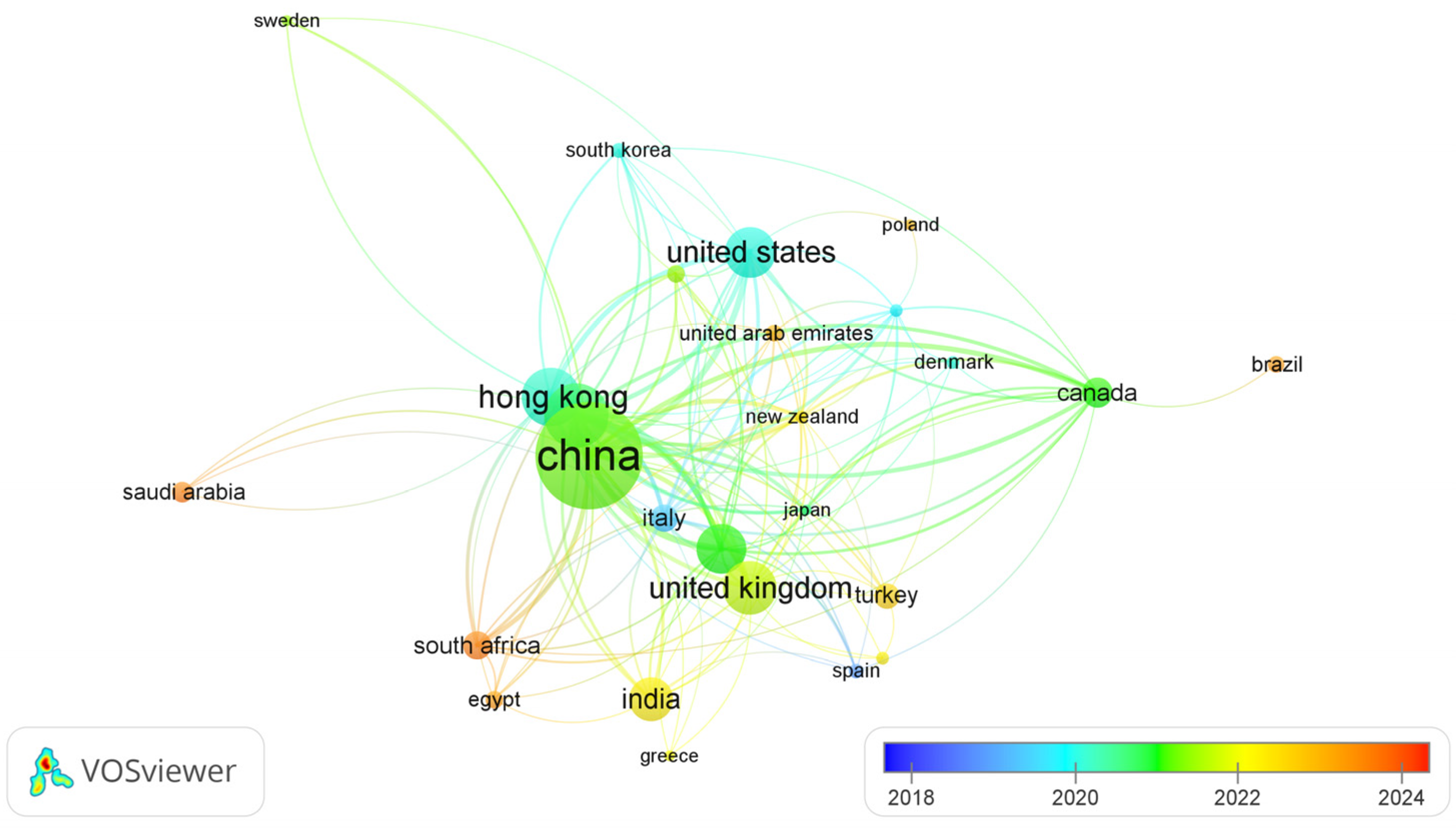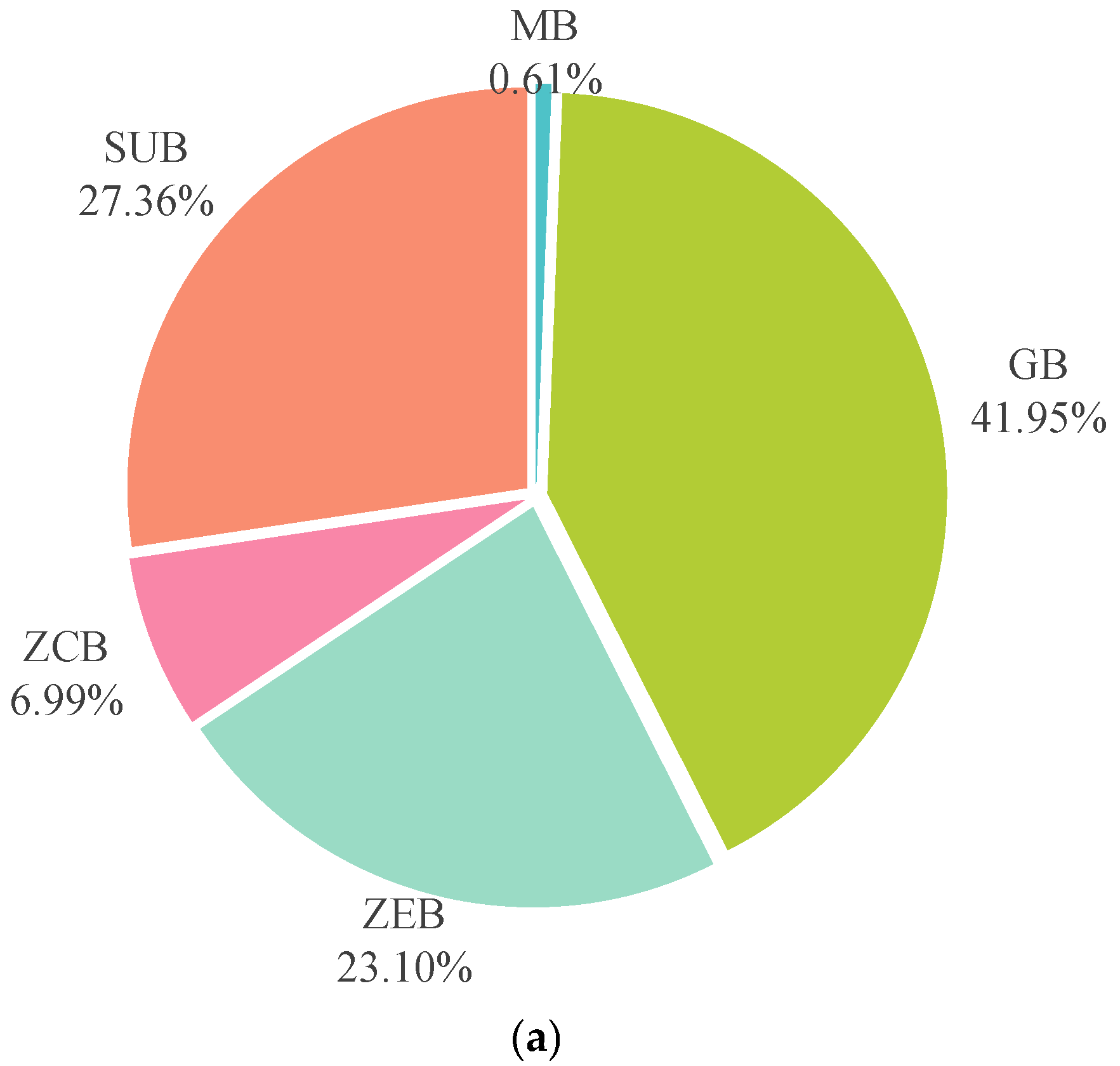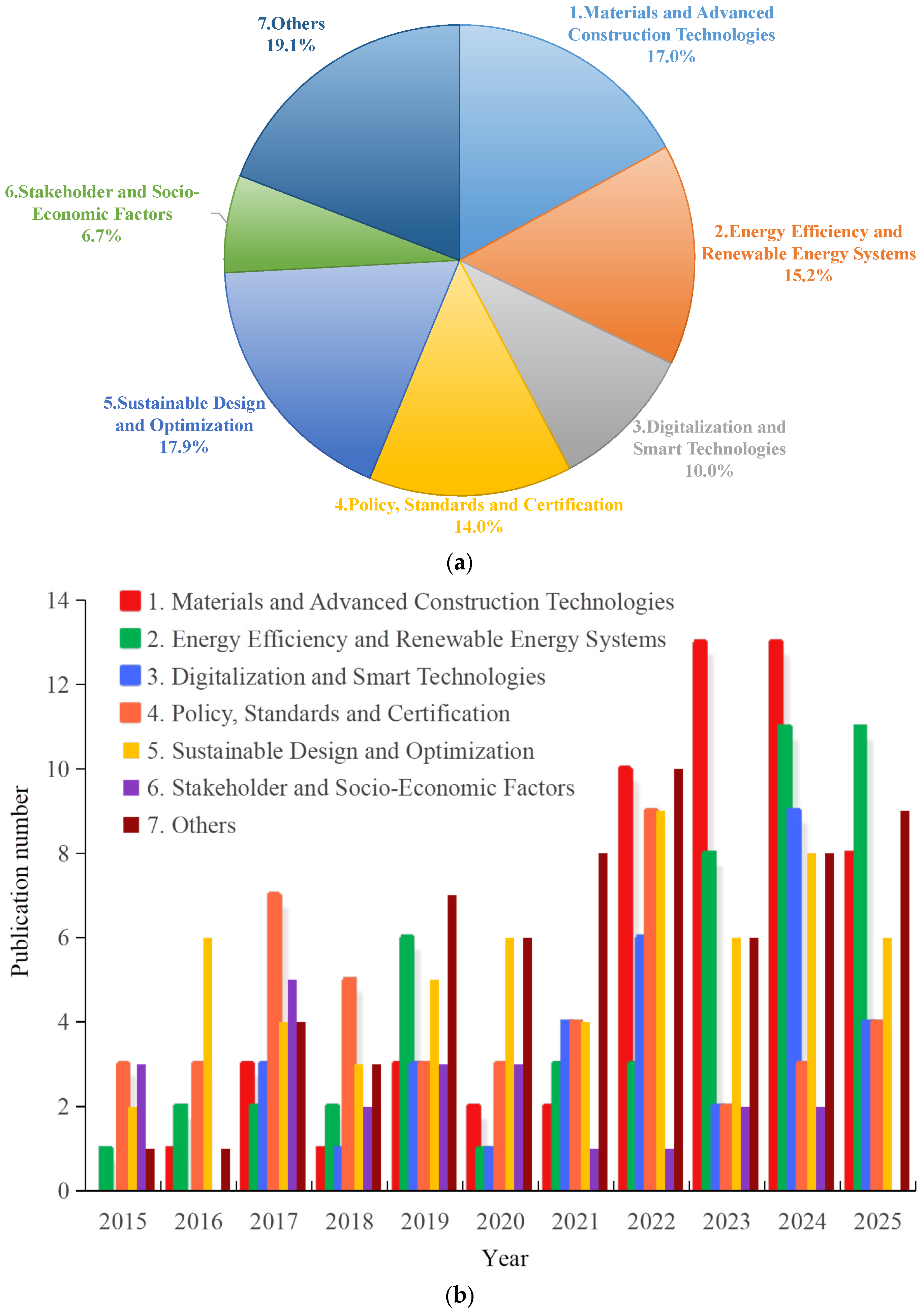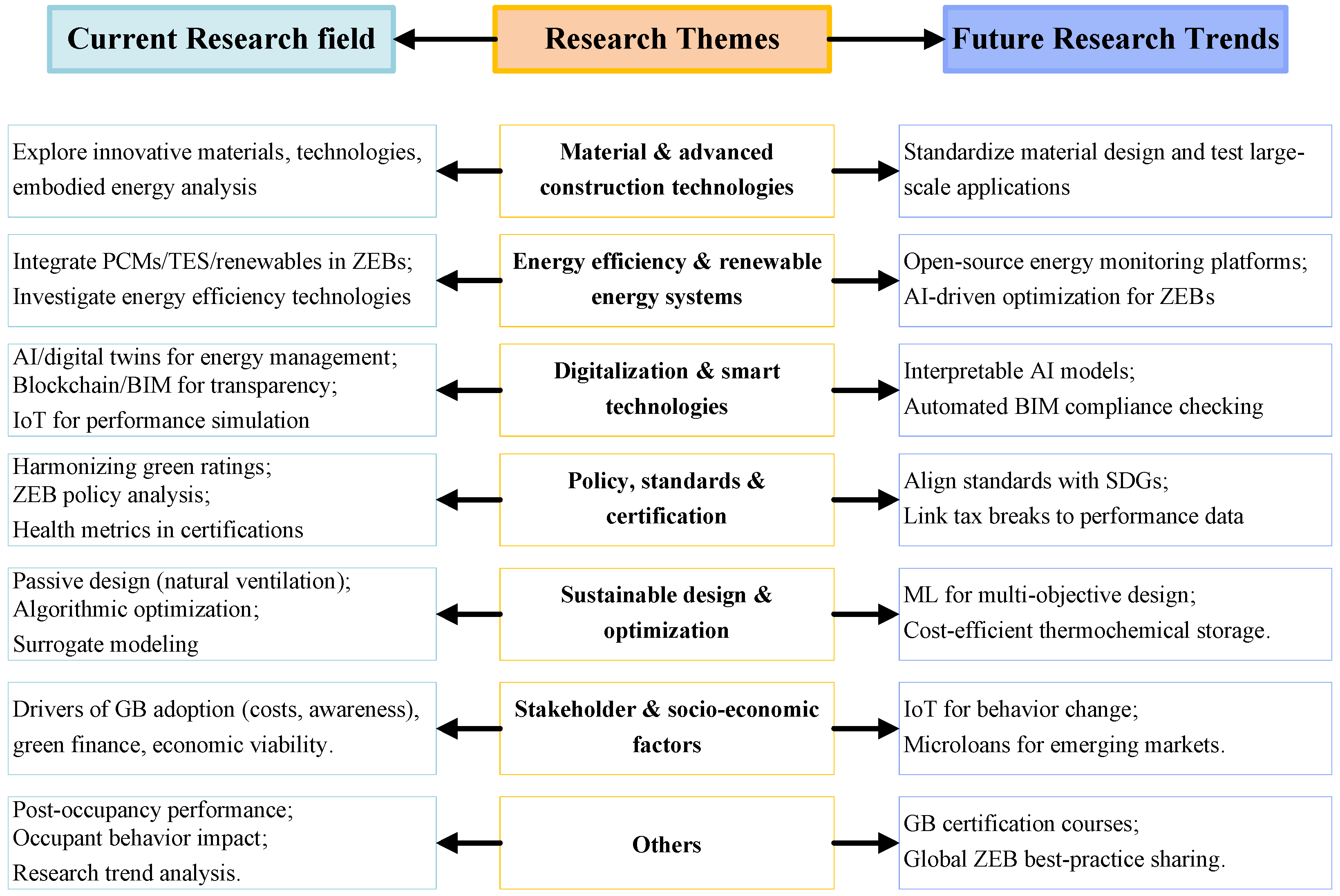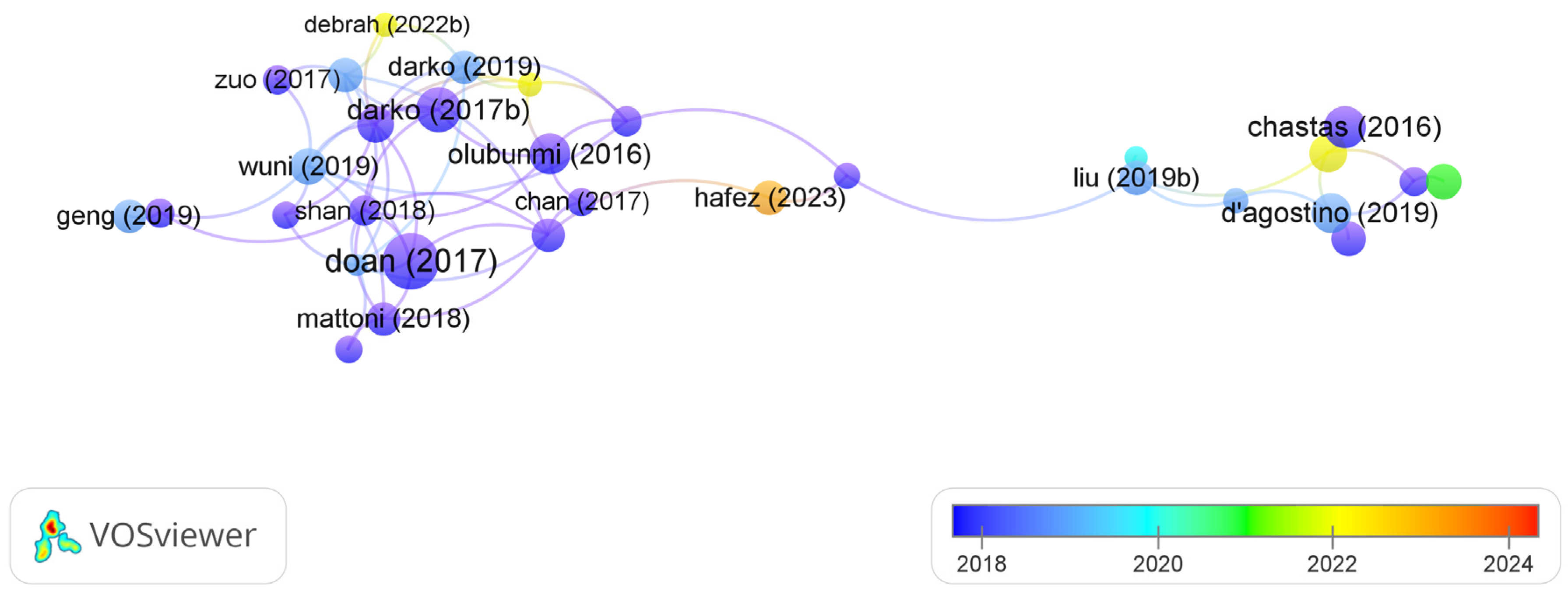1. Introduction
In response to the escalating climate crisis, achieving carbon neutrality has emerged as a key strategy to curb greenhouse gas emissions and address the environmental problems caused by the development of mankind [
1,
2]. In this context, more than 130 countries have committed to carbon neutrality goals, most targeting timelines between 2050 and 2070 [
3,
4]. The built environment plays a substantial role in this effort, responsible for approximately 30–40% of worldwide energy consumption and a third of carbon dioxide emissions [
5,
6,
7,
8,
9]. Sustainable buildings (SUBs), an umbrella term encompassing green buildings (GBs), nearly/net zero energy buildings (ZEBs), and zero carbon buildings (ZCBs), are designed to minimize environmental impact while improving energy performance, occupant health, and economic outcomes. Consequently, the adoption of SUB practices is widely considered a crucial approach for supporting carbon neutrality objectives and combating climate change [
10,
11].
In the literature, SUBs are frequently characterized by their reduced dependence on virgin resources and lower energy demands, alongside diminished emissions and waste output relative to conventional construction practices [
12,
13]. Some scholars further define SUBs as GBs that exhibit enhanced greenhouse gas (GHG) mitigation potential, thereby supporting the achievement of ZCB objectives [
14]. As defined by the US Environmental Protection Agency [
15], a GB is conceptualized as a structure designed, constructed, and operated through processes that prioritize environmental responsibility and resource efficiency across its entire lifespan. The World Green Building Council (WorldGBC) defines GBs as those designed to mitigate negative impacts on the climate and natural environment throughout their life cycle, while simultaneously improving human quality of life [
16]. The understanding of GBs is continually evolving; they are commonly defined as “providing people with healthy, applicable, efficient space and natural harmonious architecture with the maximum savings on resources (energy, land, water, materials), protection for the environment and reduced pollution throughout its whole lifecycle” [
17,
18,
19].
Despite the rapid global adoption of the ZEB concept since its emergence in the early 2000s, consensus regarding its precise definition has yet to be achieved. [
20,
21]. Torcellini et al. [
21], for instance, proposed four distinct definitions for ZEB, including site ZEB, source ZEB, cost ZEB, and emissions ZEB. According to the International Energy Agency (IEA), a ZEB operates without fossil fuels. Instead, it meets its energy demands solely through on-site renewable sources, primarily solar power [
22]. Numerous studies on building performance define ZEBs by their core characteristic: the net-zero annual equilibrium of their energy demand and renewable energy supply [
23,
24,
25]. Although the building sector is widely committed to cutting carbon emissions, it lacks a globally accepted nomenclature or benchmark for ZCBs [
26]. A variety of terms are frequently employed when referring to ZCBs, such as carbon neutral, zero carbon, net-zero carbon, zero energy, zero net energy, net-zero energy, near-zero energy, passive house, energy plus, 100% renewable, fossil-fuel free, and climate neutral [
27,
28]. The scope of balanced goals for ZCBs falls into four categories, defined by the calculation period and the geographic availability of renewable energy [
29]: (1) on-site renewables for operational carbon; (2) on-site renewables for full-life-cycle carbon; (3) on-/off-site renewables for operational carbon; (4) on-/off-site renewables for full-life-cycle carbon. In summary, while these terms are often connected and used interchangeably, they represent a conceptual hierarchy with increasing levels of specificity and meanings, as illustrated in
Figure 1:
Sustainable building (SUB): This is the broadest umbrella term, and it encompasses the entire triple bottom line of sustainability: environmental, societal, and economic impact across the building’s full life cycle.
Green building (GB): It is a subset of SUB, primarily focusing on the environmental aspect (i.e., energy, water, materials, waste, and indoor environmental quality) of sustainability.
Zero carbon building (ZCB): It focuses explicitly on the carbon emissions impact, aiming for a whole-life-cycle carbon neutrality that encompasses embodied carbon from materials and construction, not just operational energy.
Zero energy building (ZEB): It specifically targets the energy aspect to achieve energy self-sufficiency in the building.
The European Commission has established a comprehensive strategy aimed at attaining climate neutrality by 2050. Directive 2024/1275/EU [
30] on energy efficiency requires member states to compile detailed reports on structures failing to satisfy nearly ZEB criteria and to implement corrective actions for enhancing building energy performance [
31]. Key European directives, including the Energy Efficiency Directive (EED) [
32], the Energy Performance of Buildings Directive (EPBD) [
33], and the Renewable Energy Directive (RED) [
34], form a foundational framework that supports energy retrofitting and the integration of renewable sources to meet nearly ZEB standards in both new and existing building stock. As the cornerstone of the European Union’s sustainability agenda, the European Green Deal operationalizes the objectives of the UN 2030 Agenda and its Sustainable Development Goals (SDGs) [
35]. Similarly, the U.S. Department of Energy has set targets for the realization of zero-energy homes by 2020 and commercial ZEBs by 2025 [
36]. Furthermore, federal initiatives aim to fully decarbonize all public buildings by 2045 [
37]. In Australia, the Zero Emissions Residential Task Group of the Australian Sustainable Built Environment Council (ASBEC) put forward a national definition and pathway for nearly ZCBs as early as 2012 [
38], advocating for a coherent and regulated long-term transition toward zero carbon in alignment with industry consensus, acknowledging nearly ZEBs/ZCBs as crucial for meeting 2050 net-zero emissions goals. Parallel efforts are also observed in China, where the government has introduced an array of policies, standards, regulatory measures, and incentive programs designed to advance energy-efficient and low-carbon building practices [
39,
40]. In 2019, China issued the national standard Technical Standard for Nearly Zero Energy Buildings GB/T51350-2019 [
41] and national standard Calculation Standard for Carbon Emissions of Buildings GB/T 51366-2019 [
42]. In addition, China has unveiled its “dual-carbon” strategy, targeting the realization of carbon emission peaking by 2030 and carbon neutrality by 2060. This initiative reflects China’s commitment to promoting sustainable development and fostering a shared future for humankind [
43,
44]. Concurrently, numerous other countries have also established goals to achieve carbon neutrality between 2050 and 2070.
Sustainable/green building rating tools (SBRT/GBRT) serve as essential frameworks for assessing the sustainability of buildings, and numerous countries have developed their own nationally tailored SBRT/GBRT to measure and reduce the environmental impact of buildings, e.g., BREEAM (Building Research Establishment Environmental Assessment Method), developed by the UK, LEED (Leadership in Energy and Environmental Design), developed by the USA, CASBEE (Comprehensive Assessment System for Building Environmental Efficiency), developed by Japan, and GREEN STAR, developed by Australia [
45,
46]. These rating systems are widely recognized as a valuable benchmark for evaluating the environmental performance of buildings. Numerous studies have undertaken comparative analyses of different building assessment tools [
47,
48,
49], with several studies focusing on comparing specific assessment tools, e.g., LEED and ITACA [
50], BEAM and LEED [
51], LEED and BREEAM [
52]. In general, LEED and BREEAM have received the most scholarly attention, predominantly due to their global prevalence. Few other studies have extended beyond comparing these major systems to evaluate other regional assessment methods [
53,
54].
Over the past decade, the implementation of ZEBs has been broadly classified into passive and active strategies, and prior reviews have further distinguished passive strategies into passive sustainable design (i.e., geographical and meteorological factors such as site planning, layout planning, ventilation, and natural lighting) and energy-saving techniques (i.e., thermal insulation, shading design, lighting design) [
55,
56]. The active strategies include renewable energy systems (i.e., photovoltaic system, wind turbine system, geothermal system) and backup systems (i.e., fuel cell system, district heating and/or cooling system) [
20,
56]. In recent years, substantial artificial intelligence (AI) applications have been explored in buildings, which involve design optimization [
57,
58,
59,
60], smart control of building energy systems [
60,
61,
62], load prediction [
63,
64,
65], and fault detection of energy devices [
66,
67,
68]. The use of AI-driven optimization during the design phase, which employs surrogate models, is critical for integrating holistic sustainability into building projects. The integration of AI during the building design phase facilitates the holistic adoption of strategic sustainability measures. This proactive approach significantly enhances building performance from the outset of the life cycle, thereby precluding the necessity for costly future retrofits [
69].
Numerous studies have been conducted on SUBs from a specific perspective (e.g., passive strategies, active strategies, design optimization, policies, rating tools, AI-driven applications, etc.). However, few studies have systematically and comprehensively investigated the current state of SUBs by synthesizing existing review literature. This study aims to identify the characteristic distribution of the existing review literature using bibliometric analysis and analyze the main research themes as well as the motivations in the research field of SUBs. The remainder of the paper is organized as follows:
Section 2 presents the main research framework of this study, which contains three stages.
Section 3 shows a comprehensive overview of 329 review articles combining quantitative and qualitative analytical methodologies, and examines key focus areas, identifies motivations, challenges/gaps, and prospective future directions in the field. Finally,
Section 4 presents the conclusions and the main limitations.
2. Methodology
Figure 2 illustrates the three-stage research framework of this study: bibliometric analysis, scientometric analysis, and qualitative analysis. The choice of database is critical in scientific reviews, as it directly influences the quality of the findings [
70,
71,
72]. Scopus covers peer-reviewed literature across scientific, technical, medical, social science, and arts and humanities disciplines. It indexes over 27,000 journals, 210,000 books, and 9 million conference papers, making it a widely used database for bibliometric studies. Therefore, Scopus was chosen as the source database for literature retrieval in this research. In stage 1, a bibliometric search was conducted in the Scopus database to obtain the comprehensive literature of a given topic for further analysis; article title search was employed to retrieve the words “sustainable building” OR “zero carbon building” OR “green building” OR “zero energy building” OR “low carbon building” OR “low energy building”. Title search is a more precise, targeted strategy compared to keyword or abstract searching, and the results of title search are highly relevant and central to the predefined topic. This approach minimizes “noise” from articles that only mention the keywords peripherally. The publication time was set to cover the last ten years, from 2015 to 2025, and the written language was refined as English. As a result, a total of 5458 documents were identified, containing 2939 journal articles, 1665 conference papers, 333 review papers, 323 book chapters, 43 editorial materials, 41 errata, 34 conference reviews, 31 books, 17 retracted, 13 notes, 11 short surveys, 4 letters, and 4 data papers. Review papers offer a comprehensive synthesis of existing research, saving time by consolidating scattered studies into a coherent overview. By organizing, analyzing, and interpreting vast bodies of literature, they advance scholarship and are thus invaluable for researchers, educators, and policymakers. Subsequently, the titles, abstracts, and keywords were further checked and screened to make sure the selected studies met the scope of this paper. Finally, 329 review papers remained for conducting further analysis in the next stage.
In stage 2, the scientometric approach was employed to quantitatively assess research impact, citation dynamics, and knowledge evolution within a field using large-scale academic datasets, which can enhance literature reviews by addressing objectivity concerns in SUBs research samples. This study aims to identify the most influential sources, countries, keywords, and review papers in the studied field, and then classify research topics into several clusters for conducting in-depth analysis and identifying key findings and challenges. In this study, science mapping was employed to analyze and visualize bibliometric networks by using VOSviewer version 1.6.20.0. The manual of this software is freely available to download and includes supplementary details explaining the data analysis and science mapping procedures [
73,
74].
In stage 3, a comprehensive qualitative analysis was conducted on key review articles to summarize the main research themes and key findings and challenges, since these review articles are generally regarded as cornerstones in each research theme and offer researchers a consolidated overview of current advancements, critical insights, and future research directions by synthesizing diverse studies.
3. Results and Discussion
3.1. Overview of Publication Trends
Figure 3 presents the annual count of review articles on SUBs over the last ten-year period (January 2015–July 2025), revealing significant fluctuations and long-term trends in the research output of this field. The publications show an overall growth trend, from 11 publications (2015) to 57 publications (2024), indicating surging academic and industrial interest in SUBs. Publication growth was slow during the first five years but accelerated rapidly in the subsequent five-year period. In addition, the sharp rise in 2024 suggests a peak in research activity, possibly driven by global net-zero commitments (e.g., COP28, stricter building codes). The drop to 40 publications in 2025 is attributed to incomplete data for that year, as only the first half was included.
3.2. Results of Scientometric Analysis
3.2.1. Analysis of Article Sources
Figure 4 illustrates the most popular and suitable journals for publication in the SUB field, as identified through journal source analysis using VOSviewer software. A total of 112 sources were identified among the 329 review papers, and the minimum number of papers was set to 2 for each of the sources. Finally, 34 connected sources were obtained, and detailed information is provided in
Table 1. The size of a journal’s node and label corresponds to its number of publications; thus, larger nodes indicate a higher publication output. Therefore, it is obvious that
Renewable and Sustainable Energy Reviews is the most popular journal, having the highest publication number, 40 articles, and the highest citation number, 3931. The second-most popular journal was observed to be
Sustainability (Switzerland) (publication number: 33, citation number: 1250), followed by
Buildings (publication number: 23, citation number: 502),
Energy and Buildings (publication number: 20, citation number: 1993), and
Energies (publication number: 20, citation number: 539). The line connecting two nodes reflects two key characteristics: the frequency of citations between two journals and the link strength between two journals. Specifically, a thicker line represents a higher citation frequency, while a shorter distance indicates a stronger link strength between journals. With a total link strength score of 108,
Renewable and Sustainable Energy Reviews is the most active journal in the studied field, followed by
Building and Environment with a total link strength score of 91. Although the number of articles published in
Environmental Chemistry Letters,
Cleaner Engineering and Technology, and
Automation in Construction was less than 3, and the citation number was less than 200, these three journals have the highest impact on the field of SUBs, reflected by avg. norm. citations. The color of the node represents the average publication year of articles in that journal. The data indicate that
Frontiers in Built Environment began publishing research on SUBs in 2025, and
Clean Technologies and Environmental Policy,
Results in Engineering and
Journal of Facilities Management started publishing related articles in 2024. By contrast,
Applied Energy,
Current Sustainable/Renewable Energy Reports, and
Journal of Management in Engineering were the first to start publishing related articles.
3.2.2. Analysis of Article Regions
Figure 5 illustrates the main countries active in SUB research, reflecting the relationship and contribution of different regions in this field. In VOSviewer, the minimum number of articles and the minimum citation number were set to 2 and 100, respectively. Finally, a total of 26 countries were identified from 71 countries, as shown in
Table 2. The largest node was observed to be China, which had the highest number of published articles, with 83, and the highest citation numbers, with 5799. This was followed by Australia (articles = 44, citations = 3529) and Hong Kong (articles = 39, citations = 3868), and it is obvious that these three countries have made considerable contributions in the studied field. In China, the dual-carbon policy launched in 2020 may be a key factor that has greatly stimulated the enthusiasm for investigating SUBs. In Australia, the globally recognized GBRS (i.e., Green Star) program, policy guidance and promotion, and innovative technologies are possibly the main factors that greatly promote SUB development. In Hong Kong, BEAM Plus, promoted by the Hong Kong Green Building Council (HKGBC), and the “Hong Kong Climate Action Plan 2050”, launched by the government, have facilitated the low-carbon transformation of the construction industry and the realization of the global carbon neutrality goal. In addition, as the node color reflects the average publication period of articles in a country, Egypt (articles = 9), South Africa (articles = 16), Saudi Arabia (articles = 11), and Brazil (articles = 8) have recently paid great attention to the review studies regarding SUB. By contrast, Spain (articles = 7), Italy (articles = 15), and France (articles = 6) have conducted earlier review studies on the related field. Although Japan, Egypt, and New Zealand each published fewer than 10 review articles, with less than 700 citations, they demonstrate the highest impact on SUB research as reflected by their average normalized citation values.
3.2.3. Analysis of Keywords
Figure 6 presents the core keywords identified from the selected review articles that were analyzed using “Author keyword” in VOSviewer. The threshold for the minimum number of occurrences was four, and keywords representing the same concept (e.g., “green building” versus “green buildings” versus “green building (gb)”, “net zero energy building” versus “net-zero energy building” versus “nearly zero energy building” versus “zero-energy buildings” versus “zero energy buildings” versus “nzeb”, “energy saving” versus “ energy conservation”) were combined to reduce redundancy. Ultimately, 46 keywords were retained from the initial pool of 1082 after applying the thresholds, and the detailed information of the core keywords is provided in
Table 3. As the size of nodes and fonts corresponds to keyword frequency, “green buildings” (occurrences: 85) emerges as the most prevalent keyword, with “zero energy buildings” (occurrences: 45), “energy efficiency” (occurrences: 34), and “sustainable building” (occurrences: 24) following in descending order. In addition, the thickness of the connection line clearly reflects the link strength between two nodes; in other words, it reflects the frequency of co-occurrence or the intensity of cooperation of the pair of keywords. The high total link strength of a node is the sum of all connection strengths of the node. It was observed that the high total link strength of “green buildings” and “sustainability” reflect their roles as cross-cutting themes in SUB research, linking sustainable development, renewable energy, and energy efficiency topics. Keyword occurrence periods are color-coded, revealing a clear shift: while earlier literature frequently addressed “construction industry”, “review”, “life cycle assessment”, “green buildings”, and “barriers”, contemporary research focuses on “sustainable construction”, “artificial intelligence”, “bibliometric analysis”, “sustainable materials”, “smart cities”, “building information modeling”, and “building materials”. Although the keywords “construction industry,” “systematic review”, “circular economy”, “energy conservation”, “sustainable construction”, “artificial intelligence”, and “energy” each have no more than 10 occurrences, their high average normalized citation scores demonstrate their notable impact in recent research.
3.2.4. Analysis of Document Citations
Figure 7 presents the map of citation patterns for key documents, which were derived based on citation number and normal citations determined in VOSviewer. The threshold for the minimum citation number was 150; initially, 45 items out of 329 review articles were determined to meet the threshold, but only 31 items were observed to be connected and were thus selected for analysis. Detailed information on the top 31 most highly cited review articles is provided in
Table 4. Two principal metrics, citation number and normal citation, are generally accepted to serve as important measures of an article’s academic influence and value. In terms of citation number, two review articles, i.e., “A critical comparison of green building rating systems”, published in 2017 and “Drivers for green building: a review of empirical studies”, published in 2017, are particularly notable for having the most citations. In terms of normal citation, another three review articles, i.e., “Residential net-zero energy buildings: review and perspective”, “Energy efficiency in sustainable buildings: a systematic review with taxonomy, challenges, motivations, methodological aspects, recommendations, and pathways for future research”, and “Assessment of the renewable energy generation towards net-zero energy buildings: a review”, were deemed the most influential articles, although they were all published after 2020, and the citation numbers were less than 300. It is notable that only 6 out of the 31 most highly cited review articles were identified as being published after 2020.
Table 4.
List of 31 most highly cited review papers.
Table 4.
List of 31 most highly cited review papers.
| Article | Title | Source | Citation Numbers | Norm. Citations |
|---|
| Wu (2021) [76] | Residential net-zero energy buildings: review and perspective | Renewable and Sustainable Energy Reviews | 270 | 5.35 |
| Hafez (2023) [77] | Energy efficiency in sustainable buildings: a systematic review with taxonomy, challenges, motivations, methodological aspects, recommendations, and pathways for future research | Energy Strategy Reviews | 263 | 5.29 |
| Ahmed (2022) [78] | Assessment of the renewable energy generation towards net-zero energy buildings: a review | Energy and Buildings | 297 | 5.18 |
| Doan (2017) [79] | A critical comparison of green building rating systems | Building and Environment | 486 | 4.81 |
| Darko (2017) [80] | Drivers for green building: a review of empirical studies | Habitat International | 368 | 3.64 |
| Debrah (2022b) [81] | Artificial intelligence in green building | Automation in Construction | 169 | 2.95 |
| Debrah (2022a) [82] | Green finance gap in green buildings: a scoping review and future research needs | Building and Environment | 166 | 2.89 |
| Chastas (2016) [83] | Embodied energy in residential buildings-towards the nearly zero energy building: a literature review | Building and Environment | 334 | 2.77 |
| Olubunmi (2016) [84] | Green building incentives: a review | Renewable and Sustainable Energy Reviews | 323 | 2.68 |
| D’agostino (2019) [85] | What is a nearly zero energy building? overview, implementation and comparison of definitions | Journal of Building Engineering | 313 | 2.48 |
| Mattoni (2018) [49] | Critical review and methodological approach to evaluate the differences among international green building rating tools | Renewable and Sustainable Energy Reviews | 259 | 2.44 |
| Darko (2016a) [86] | Critical analysis of green building research trend in construction journals | Habitat International | 287 | 2.38 |
| Wuni (2019) [87] | Scientometric review of global research trends on green buildings in construction journals from 1992 to 2018 | Energy and Buildings | 289 | 2.29 |
| Darko (2016b) [88] | Review of barriers to green building adoption | Sustainable Development | 224 | 2.22 |
| Liu (2019b) [89] | Application and suitability analysis of the key technologies in nearly zero energy buildings in China | Renewable and Sustainable Energy Reviews | 267 | 2.12 |
| Zhao (2019) [90] | A bibliometric review of green building research 2000–2016 | Architectural Science Review | 266 | 2.11 |
| Shan (2018) [91] | Green building rating systems: global reviews of practices and research efforts | Sustainable Cities and Society | 223 | 2.10 |
| Zuo (2017) [92] | Green building evaluation from a life-cycle perspective in australia: a critical review | Renewable and Sustainable Energy Reviews | 212 | 2.10 |
| Zhang (2017) [93] | Comparison of evaluation standards for green building in china, britain, united states | Renewable and Sustainable Energy Reviews | 212 | 2.10 |
| Cabeza (2020) [20] | Technological options and strategies towards zero energy buildings contributing to climate change mitigation: a systematic review | Energy and Buildings | 163 | 2.09 |
| Chan (2017) [94] | Barriers affecting the adoption of green building technologies | Journal of Management in Engineering | 210 | 2.08 |
| Geng (2019) [95] | A review of operating performance in green buildings: energy use, indoor environmental quality and occupant satisfaction | Energy and Buildings | 252 | 2.00 |
| Darko (2019) [96] | A scientometric analysis and visualization of global green building research | Building and Environment | 251 | 1.99 |
| Kylili (2015) [97] | European smart cities: the role of zero energy buildings | Sustainable Cities and Society | 267 | 1.89 |
| Chen (2015) [98] | A comprehensive review on passive design approaches in green building rating tools | Renewable and Sustainable Energy Reviews | 257 | 1.82 |
| Zhang (2018) [99] | Turning green into gold: a review on the economics of green buildings | Journal of Cleaner Production | 193 | 1.82 |
| Lu (2015) [100] | Design optimization and optimal control of grid-connected and standalone nearly/net zero energy buildings | Applied Energy | 212 | 1.50 |
| Liu (2019a) [101] | A comprehensive analysis on definitions, development, and policies of nearly zero energy buildings in china | Renewable and Sustainable Energy Reviews | 181 | 1.44 |
| Wei (2015) [102] | Indoor air quality requirements in green building certifications | Building and Environment | 200 | 1.41 |
| Zhao (2015) [103] | Social problems of green buildings: from the humanistic needs to social acceptance | Renewable and Sustainable Energy Reviews | 187 | 1.32 |
| Zhang (2019) [104] | A survey of the status and challenges of green building development in various countries | Sustainability (Switzerland) | 151 | 1.20 |
Figure 7.
Mapping of document citation patterns [
49,
77,
79,
80,
81,
83,
84,
85,
87,
89,
91,
92,
94,
95,
96].
Figure 7.
Mapping of document citation patterns [
49,
77,
79,
80,
81,
83,
84,
85,
87,
89,
91,
92,
94,
95,
96].
3.3. Analysis of Research Themes
The total of 329 articles were classified into five different research groups based on building types as indicated by their titles: GB, ZEB, ZCB, SUB, and MB (mixed buildings that significantly addressed multiple specific categories, e.g., both ZEB and ZCB). It is important to note that these categories are not mutually exclusive but reflect the paper’s emphasis.
Figure 8 shows the research proportion of different types of buildings in the studied articles and the publication trends of different types of buildings in different years. It was found that studies on GB (41.95%) dominate the field, followed by SUB (27.36%) and ZEB (23.10%), while ZCB (6.99%) and MB (0.61%) only account for a small part. Further investigation reveals that research interest in GBs peaked in 2019 (21 publications), declined sharply to approximately 10 publications annually in 2021–2022, then rebounded to a second peak in 2022 (23 publications) before entering a renewed decline. The initial downturn may be attributed to pandemic-related disruptions, whereas the subsequent decrease likely reflects a research focus shift driven by dual-carbon policy priorities, particularly toward ZEB and SUB paradigms. Studies on ZEB and SUB have demonstrated consistent growth, culminating in peak publication outputs in 2024 (ZEB = 16, SUB = 25), and the government incentives (e.g., tax credits, grants) for ZEB/SUB are possibly a key factor that has boosted academic and industry interest. However, studies on ZCB have remained relatively stable, increasing only marginally from two publications in 2015 to four in 2024.
This study classifies SUB research into seven themes, and
Figure 9 shows the categories of research themes (
Figure 9a) and the publication trends under each category (
Figure 9b). The seven themes are material and advanced construction technologies (17.0%), energy efficiency and renewable energy systems (15.2%), digitalization and smart technologies (10.0%), policy, standards, and certification (14.0%), sustainable design and optimization (17.9%), stakeholder and socio-economic factors (6.7%), and others (19.1%). The “others” category comprises articles addressing general or specific topics (e.g., terminology, indicators, critical success factors) that do not belong to the above six primary themes. An overall growth trend was observed for all seven themes. In the initial year (2015), all seven themes had limited publications, each with fewer than five articles. However, publications on both material and advanced construction technologies and energy efficiency and renewable energy systems numbered more than 10 in 2024; breakthroughs in sustainable materials (e.g., carbon-neutral cement), advances in solar/wind technology and policy implementation were the possible reasons accelerating the sharp increase in these publications. Similar publication numbers were observed for three categories in 2014, i.e., digitalization and smart technologies (9), sustainable design and optimization (8), and others (8). The remaining two categories, i.e., stakeholder and socio-economic factors and policy, standards, and certification, showed minor fluctuations. In addition, the publication reduction in several categories in 2020 and 2021 may be caused by COVID-19 pandemic disruptions. Increased attention and research output are anticipated for all seven themes in the future.
The seven research themes identified in this study paint a picture of the features of building sustainability. Theme 1—Material and advanced construction technologies, theme 2—Energy efficiency and renewable energy systems, and theme 3—Digitalization and smart technologies primarily address the environmental pillar, aiming to reduce resource consumption and ecological impact. Theme 4—Policy, standards, and certification provides the regulatory and evaluative framework for driving the of goals of building sustainability. Theme 5—Stakeholder and socio-economic factors mainly addresses the social and economic pillars, exploring drivers, barriers, and financial mechanisms. Theme 6—Sustainable design and optimization serves as an integrative practice that balances the three pillars of building sustainability (i.e., environment, society, and economy). Achieving true sustainability in the built environment demands simultaneous advancements across all interconnected areas, moving beyond a narrow focus on energy and carbon to embrace broader socio-economic well-being and resilience.
3.4. Analysis of Motivations, Key Findings, and Future Research Direction
Based on the seven research themes analyzed in
Section 3.3, the motivations, key findings, and challenges/future research directions were further investigated and summarized as provided in
Table 5,
Table 6 and
Table 7.
In the theme of material and advanced construction technologies, the construction industry is a major contributor to global carbon emissions, primarily due to energy-intensive materials like concrete and steel, and transitioning to sustainable materials could reduce construction-related emissions by up to 40%, aligning with global decarbonization goals.
The primary motivations are to reduce the environmental footprint of buildings by the following means: (1) Promoting innovative materials (e.g., hemp concrete [
105], geopolymers [
106]) that offer comparable structural performance with lower emissions. (2) Exploring biomaterials (e.g., piezoelectric materials for biomedical uses [
107]) to bridge sustainability with functionality. (3) Reviving traditional techniques (e.g., cob construction [
108]) for heritage preservation and modern sustainability, and implementation of 3D printing concrete technology in construction sector for enhancing the performance and sustainability of building projects [
109,
110,
111]. (4) Quantifying embodied energy to highlight the life cycle impact of materials, pushing for low-carbon alternatives.
The main key findings include the following: (1) The dominance of embodied energy in ZEBs underscores the need for low-carbon materials like hemp concrete and GeoC. These materials not only reduce emissions but also utilize waste (e.g., industrial byproducts for GeoC). (2) Piezoelectric materials represent a dual-purpose innovation, combining structural functionality with energy generation.
The main challenges/future research directions include the following: (1) Invest in nanotechnology to enhance piezoelectric biomaterial properties. (2) Partner with manufacturers to standardize GeoC mix designs and test large-scale applications.
In the theme of energy efficiency and renewable energy systems, buildings consume about 40% of global energy, making energy efficiency and renewable energy critical for climate mitigation, and widespread ZEB adoption could cut global building energy use by 50%, significantly reducing reliance on fossil fuels.
The main motivations include the following: (1) Integrating renewables (solar, wind) to achieve energy self-sufficiency in ZEBs [
25,
112,
113,
114]. (2) Addressing intermittency issues in renewables via latent heat and thermochemical storage in thermal energy storage [
115,
116]. (3) Tailoring solutions (e.g., ZEBs in China) to local climates and infrastructure [
39,
117,
118].
The main key findings include the following: (1) Climate-specific ZEB designs highlight the importance of localized solutions, rejecting a one-size-fits-all approach. (2) Phase change materials (PCMs) offer efficient thermal storage, addressing renewable energy intermittency. (3) Thermochemical storage is impractical for small-scale applications due to material limitations.
The main challenges/future research directions include the following: (1) Develop open-source platforms integrating lifecycle energy analysis with real-time monitoring. (2) Tailor ZEB configurations to regional climates using AI-driven optimization.
In the theme of digitalization and smart technologies, smart technologies could improve building energy efficiency by 20–30%, accelerating smart city development. Digital tools can optimize sustainability by enabling real-time monitoring and predictive analytics.
In the theme of policy, standards, and certification, stronger policies could increase GB market penetration from 10% to 50% by 2030. However, inconsistent policies hinder global GB adoption.
The main motivations include the following: (1) Harmonizing GBRSs (e.g., LEED, BREEAM) to standardize sustainability metrics [
47,
52]. (2) Analyzing ZEB policies in Europe and China to identify best practices [
39,
44,
97]. (3) Incorporating health metrics (e.g., indoor air quality) into certifications [
102].
The main key findings include the following: (1) Inconsistent ZEB definitions and regional policies (e.g., in Europe and China) create market fragmentation. (2) GBRS like LEED and BREEAM prioritize energy but overlook passive design and holistic sustainability. (3) Certification tools fail to address all sustainability dimensions (e.g., social equity). (4) Developing economies lag in GBs research and policy formulation.
The main challenges/future research directions include the following: (1) Align GBRSs with UN SDGs. (2) Link tax breaks to verified post-occupancy performance.
In the theme of sustainable design and optimization, design choices determine 80% of a building’s environmental impact, and optimized designs could reduce operational energy use by 30–60%.
The main motivations include the following: (1) Passive design strategies (e.g., natural ventilation) to minimize energy use [
98,
118,
124,
125]. (2) Algorithmic optimization for energy and carbon efficiency [
126,
127]. (3) Surrogate-assisted modeling to expedite design processes [
57,
128].
The main key findings include the following: (1) Passive design strategies (e.g., natural ventilation) are cost-effective yet undervalued in rating systems. (2) Digital tools automate optimization but often prioritize cost over operational energy savings.
The main challenges/future research directions include the following: (1) Use machine learning to automate multi-objective optimization. (2) Improve cost-efficiency of thermochemical storage for ZEBs.
In the theme of stakeholder and socio-economic factors, human behavior and economics drive GB adoption, and addressing socio-economic barriers could double GB adoption rates in developing nations.
In other themes, the topics are quite extensive, generally merging engineering, policy, and digital technologies for holistic solutions.
The main motivations include the following: (1) Identifying current developments, the state-of-the-art advancements, recurring trends and emerging patterns in GB research [
131,
132]. (2) Evaluating the post-occupancy performance of GBs [
95,
133].
The main key findings include the following: (1) Post-occupancy data reveals GBs outperform conventional buildings in user satisfaction, but IAQ inconsistencies persist. (2) Occupant behavior significantly impacts ZEB performance, emphasizing the need for user engagement. (3) Subjective classification of research frontiers complicates global benchmarking.
The main challenges/future research directions include the following: (1) Launch GB certification courses for professionals. (2) Establish research consortia to share ZEB best practices.
In summary, the motivations behind these research themes are deeply rooted in the urgent need to decarbonize the built environment while addressing technical, economic, and social barriers. By advancing materials, energy systems, digital tools, and policies, these studies lay the groundwork for a sustainable transformation in construction—one that balances environmental imperatives with human well-being and economic feasibility. Therefore, these motivations reflect a global imperative to mitigate climate change, optimize resource efficiency, and foster socio-economic resilience in the built environment. The key findings reveal both progress and persistent gaps in SUB research. While advancements in materials, digital tools, and design optimization are promising, challenges like policy fragmentation, stakeholder misalignment, and scalability barriers remain. Addressing these issues requires coordinated efforts across academia, industry, and policymakers to accelerate the transition to a sustainable built environment. The identified challenges underscore the need for systemic changes in research, policy, and industry practices. Future efforts must prioritize scalability (materials), transparency (AI), inclusivity (stakeholders), and global harmonization (standards). By addressing these gaps, the building sector can achieve its net-zero targets while ensuring equitable access to sustainable solutions.
3.5. Challenges and Future Directions
The preceding analysis of dominant research paradigms in this domain provides the foundation for identifying critical knowledge gaps and future research priorities in sustainable construction.
Figure 10 presents a structured framework delineating prospective research trajectories, with primary recommendations encompassing the following:
For material and advanced construction technologies: Current research focuses on low-carbon materials such as hemp concrete and geopolymers, which reduce emissions by replacing traditional energy-intensive materials. Biomaterials such as piezoelectric systems merge sustainability with functionality, while traditional techniques (e.g., cob construction) offer heritage-compatible solutions. Future work must scale these materials through nanotechnology enhancements and industrial partnerships to standardize mixes such as GeoC for broader adoption.
For energy efficiency and renewable energy systems: ZEBs are central to cutting building energy use by integrating renewables, such as solar and wind, and mitigating intermittency through thermal storage (e.g., PCMs). However, thermochemical storage remains impractical for small-scale use. Future efforts should leverage AI-driven design optimization and open-source platforms to tailor ZEBs to regional climates and enhance real-time energy tracking.
For digitalization and smart technologies: AI and digital twins facilitate predictive maintenance, whereas blockchain and BIM improve supply chain transparency. However, dependence on opaque AI models and disjointed data hampers trust. Future research should focus on interpretable AI for energy management and leverage BIM to automate compliance checks, thereby simplifying the process of green certification.
For policy, standards, and certification: Inconsistent GB standards (e.g., LEED, BREEAM) and regional ZEB definitions, impede global advancement. Current standards and certifications prioritize energy efficiency and environmental performance, with social sustainability being underrepresented. The evolution of future SUB standards must therefore encompass a broader framework that integrates social equity, occupant health, and cultural heritage. This can be achieved by introducing credits for community engagement and local job creation (Social equity), extending health criteria beyond air quality to include well-being metrics such as access to natural light, biophilic design elements, and acoustic comfort (Occupant health), and incentivizing adaptive reuse as well as traditional techniques to reduce embodied carbon while maintaining cultural continuity (Cultural heritage).
For sustainable design and optimization: Operational energy can be reduced by 30–60% using passive strategies (e.g., natural ventilation) and algorithmic optimization (e.g., Non-dominated Sorting Genetic Algorithm (NSGA)). However, digital tools often prioritize cost over sustainability. Machine learning offers new opportunities to balance multiple objectives, and cost reductions in thermal storage technologies could accelerate ZEB deployment.
For stakeholder and socio-economic factors: Non-financial incentives (e.g., health benefits) drive GB adoption more effectively than cost savings. However, knowledge gaps and weak stakeholder collaboration impede progress. IoT feedback systems can promote energy-efficient behavior, and green microloans could expand access in emerging markets.
For others: Empirical evidence from post-occupancy studies indicates superior occupant satisfaction levels in green-certified buildings relative to traditional counterparts. Nevertheless, significant variations in IAQ parameters and occupant engagement behaviors continue to present implementation challenges. This suggests the critical need for developing comprehensive professional accreditation systems and forming global knowledge-sharing consortia to institutionalize evidence-based best practices.
In summary, the future of sustainable construction hinges on scalable materials, integrated digital tools, inclusive policies, and socio-economic engagement. Addressing fragmentation in standards, stakeholder collaboration, and cost barriers will be critical to achieving net-zero targets equitably.
4. Conclusions
This study employed a rigorous mixed-methods approach to analyze the evolution of SUB research from 2015 to 2025, combining bibliometric, scientometric, and qualitative methodologies. The research framework comprised three key stages: (1) a systematic literature search in Scopus using keywords; (2) scientometric analysis using VOSviewer to map publication trends, regional contributions, keyword co-occurrence, and citation networks; (3) thematic analysis of 329 review papers to distill motivations, findings, and challenges across seven research themes. Research on SUBs has expanded significantly, particularly after 2020, driven by global net-zero commitments. The field is dominated by studies on GBs (41.95%), followed by SUBs (27.36%) and ZEBs (23.10%), with ZCBs receiving less attention (6.99%). China, Australia, and Hong Kong are the leading contributors, reflecting strong regional policy support and research investment.
The analysis identified seven key research themes: materials and advanced construction technologies, energy efficiency and renewable energy systems, digitalization and smart technologies, policy and certification, sustainable design and optimization, stakeholder and socio-economic factors, and other cross-cutting topics. Innovations in low-carbon materials, AI-driven energy management, and digital tools like BIM and IoT represent major advancements. Future research should focus on enhancing material performance through nanotechnology, developing interpretable AI models for building optimization, harmonizing international certification systems, and promoting inclusive stakeholder engagement. This review provides a foundational roadmap for accelerating progress toward ZEBs and ZCBs, emphasizing the need for integrating technological innovation with socio-economic and policy strategies.
This study has several limitations that also provide opportunities for future research: (1) The exclusive reliance on Scopus may have omitted relevant studies available in other databases, potentially affecting review comprehensiveness. (2) The restriction to English-language publications may overlook valuable insights from non-English studies. (3) The investigated literature is retrieved through title-based searches, which may have missed relevant reviews that used different terminology. (4) The contradictions between different studies were not explored in-depth in this study, which may cause confirmation bias and prevent a balanced, comprehensive perspective in the literature review. Therefore, future analyses of review articles should: (i) employ Boolean search operators across multiple databases to provide broader literature coverage; (ii) incorporate non-English studies, perhaps with the aid of machine translation tools, to capture diverse regional insights; (iii) explicitly seek out and analyze the contradictions between different studies to propose harmonized frameworks; (iv) intentionally include multiple document types to better capture policy reports and gray literature from underrepresented regions.
